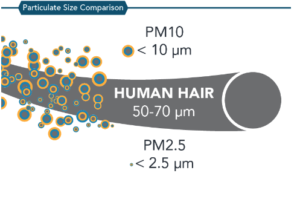PM10 and PM2.5 Understanding the differences and potential health risks associated with each is important for developing effective policies and strategies to improve air quality.
What is Particulate Matter?
Particulate matter (PM) is made of solid particles and liquid droplets in the air. PM can come from many places. Generally, any burning or dust-generating activity is a PM source.
They are further classified into PM2.5 and PM10 based on particle diameter. However, various types of research have shown that we still need more PM2.5 and PM10 monitors to create a representative picture of PM pollution.
Airborne particulate matter (PM) is not a single pollutant but a mixture of many chemical species.
- Those with a diameter of 10 microns or less (PM10) are inhalable into the lungs and can induce adverse health effects.
- Delicate particulate matter is particles that are 2.5 microns or less in diameter (PM2.5).
- Therefore, PM2.5 comprises a portion of PM10.
What is the Difference Between PM10 and PM2.5?
Particulate matter (PM) includes microscopic matter suspended in air or water.
- PM10 includes particles less than 10 µm in diameter,
- PM2.5 that less than 2.5 µm.
- Airborne particles are called aerosols.
PM10 and PM2.5 often derive from different emissions sources and also have different chemical compositions. Emissions from the combustion of gasoline, oil, diesel fuel, or wood produce much of the PM2.5 pollution found in outdoor air and a significant proportion of PM10. PM10 also includes dust from construction sites, landfills, agriculture, wildfires and brush/waste burning, industrial sources, wind-blown dust from open lands, pollen, and fragments of bacteria.
The relative sizes of PM10 and PM2.5 particles are compared in the figure below.
What Kinds of Harmful Effects Can Particulate Matter Cause?
For PM2.5, short-term exposures (up to 24 hours duration) have been associated with premature mortality, increased hospital admissions for heart or lung causes, acute and chronic bronchitis, asthma attacks, emergency room visits, respiratory symptoms, and restricted activity days.
These adverse health effects have been reported primarily in infants, children, and older adults with preexisting heart or lung diseases. In addition, of all the common air pollutants, PM2.5 is associated with the most significant proportion of adverse health effects related to air pollution, both in the United States and worldwide.
Short-term exposures to PM10 have been associated primarily with worsening respiratory diseases, including asthma and chronic obstructive pulmonary disease (COPD), leading to hospitalization and emergency department visits.
Long-term (months to years) exposure to PM2.5 has been linked to premature death, particularly in people with chronic heart or lung diseases, and reduced lung function growth in children. The effects of long-term exposure to PM10 are less clear.
Who is at the Greatest Risk from Exposure to Particulate Matter?
Older adults with chronic heart or lung disease, children, and asthmatics are most likely to experience adverse health effects from PM10 and PM2.5.
Also, children and infants are susceptible to harm from inhaling pollutants such as PM because they inhale more air per pound of body weight than adults – they breathe faster, spend more time outdoors, and have smaller body sizes. In addition, children’s immature immune systems may cause them to be more susceptible to PM than healthy adults.
How Does Particulate Matter Affect the Environment?
PM, primarily PM2.5, affects visibility by altering how light is absorbed and scattered in the atmosphere. Concerning climate change, some constituents of the ambient PM mixture promote climate warming (e.g., black carbon).
In contrast, others have a cooling influence (e.g., nitrate and sulfate). So ambient PM has both climate warming and cooling properties. PM can adversely affect ecosystems, including plants, soil, and water, through the deposition of PM and its subsequent uptake by plants or sediment into the water, affecting water quality and clarity. PM deposition on surfaces leads to the soiling of materials. PM’s metal and organic compounds have the most significant potential to alter plant growth and yield.
Is Particulate Matter a Problem Indoors?
Especially PM2.5. These particles enter indoor spaces through doors, windows, and “leakiness” in building structures. Particles can also arise from indoor sources. Particles of indoor origin include biological components and many known allergens, such as pollens, mold spores, dust mites, and cockroaches. Indoor activities also generate particles, including smoking tobacco, cooking, burning wood, candles, or incense. Particles also can form indoors from complex reactions of gaseous pollutants emitted from such sources as household cleaning products and air fresheners.
What are the Ambient Air Quality Standards for Particulate Matter?
Ambient air quality standards define the maximum amount of pollutants in outdoor air without harming human health. In 2002, the Board adopted a new annual average standard for PM2.5 ppm. It retained the annual and 24-hour standard for PM10. The national average yearly PM2.5 standard was revised in 2012.
The 2012 review resulted in the retention of the current 24-hour average PM2.5 and PM10 standards.
| Particulate Matter | Size | Sources | Health Effects |
|---|---|---|---|
| PM2.5 | 2.5 micrometers or smaller | Combustion of fossil fuels, wildfires, dust, pollen | Heart and lung disease, stroke, cancer, respiratory illness |
| PM10 | 10 micrometers or smaller | Road dust, construction, agriculture, mining | Respiratory illness, lung damage, heart disease |



